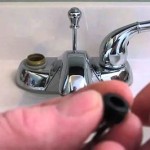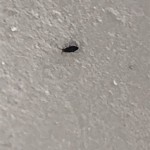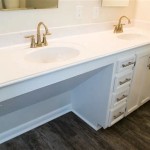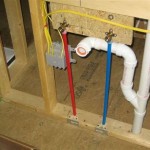Why Do My Bathroom Sinks Smell Like Sewer?
A persistent sewer-like odor emanating from bathroom sinks is a common household issue. The unpleasant smell indicates a problem within the drainage system, potentially affecting indoor air quality and overall sanitation. Identifying and addressing the source of the foul odor is essential for maintaining a healthy and comfortable living environment. This article will explore the various reasons behind this problem and outline potential solutions.
The P-Trap: A First Line of Defense and Potential Culprit
The P-trap, a U-shaped pipe located under the sink, is designed to hold a small amount of water. This water acts as a barrier, preventing sewer gases from rising up through the drain and into the bathroom. The P-trap represents the first, and often primary, suspect when investigating sewer smells.
Evaporation: If the sink is not used regularly, the water in the P-trap can evaporate, breaking the seal and allowing sewer gases to escape. This is especially common in guest bathrooms or infrequently used sinks. A simple solution is to run water down the drain for a few minutes to refill the trap. Periodic use of all drains in a dwelling is a preventative measure.
Insufficient Water: In some cases, the P-trap may not hold enough water to create an effective seal. This can be due to a poorly designed or installed P-trap, or potentially siphoning effects caused by other plumbing fixtures. Verify that the P-trap is correctly installed and not damaged.
Siphoning: Siphoning occurs when the water in the P-trap is sucked out due to pressure changes in the plumbing system. This can happen when a toilet is flushed or a washing machine drains, creating a vacuum that pulls water from nearby P-traps. If siphoning is suspected, installing an air admittance valve (AAV), also known as a Studor vent, can introduce air into the drain line, preventing the vacuum from forming.
Blockages: Partial blockages within the drainpipe, even beyond the P-trap, can disrupt the flow of water and contribute to sewer smells. Accumulated hair, soap scum, and other debris can create a breeding ground for bacteria, which release foul-smelling gases. Regular cleaning of the drain with a drain snake or enzymatic drain cleaner can help prevent blockages.
Biofilm Buildup: A Slimy Source of Odor
Biofilm is a slimy layer of microorganisms that can accumulate on the inner surfaces of drainpipes. This biofilm harbors bacteria that break down organic matter and release hydrogen sulfide, a gas responsible for the characteristic rotten egg or sewer smell. Biofilm is particularly prevalent in drains that are not regularly cleaned or flushed.
Formation and Composition: Biofilm forms in moist environments where organic matter is available as a food source for bacteria. The biofilm matrix provides a protective environment for the bacteria, making it difficult to eradicate with simple flushing. The composition of biofilm can vary depending on the types of bacteria present and the organic matter available.
Cleaning Strategies: Removing biofilm requires more than just flushing the drain with water. Disinfectants such as bleach can kill bacteria, but they may not effectively remove the biofilm matrix. Enzymatic drain cleaners are designed to break down organic matter and can be more effective at removing biofilm. Regularly flushing the drain with hot water and baking soda can also help to prevent biofilm buildup.
Prevention: Preventing biofilm buildup is crucial for maintaining a clean and odor-free drain. Avoid pouring grease, oil, or food scraps down the drain, as these provide a food source for bacteria. Regularly clean the drain with an enzymatic drain cleaner or a mixture of baking soda and vinegar. Flushing the drain with hot water after each use can also help to prevent biofilm formation.
Ventilation Issues: The Plumbing System's Breathing Mechanism
The plumbing system relies on a network of vents to allow air to enter the drainpipes, preventing pressure imbalances and ensuring proper drainage. These vents typically extend from the drainpipes up through the roof of the house. If the vents are blocked or improperly installed, it can disrupt the flow of air and contribute to sewer smells.
Vent Location and Function: Plumbing vents are typically located on the roof of the house, but can also be found on the side of the house in certain circumstances. Their primary function is to allow air to enter the drainpipes, preventing a vacuum from forming when water drains. This vacuum can siphon water from the P-traps, breaking the seal and allowing sewer gases to escape. Vents also allow sewer gases to escape upwards and away from the house.
Blockages: Vents can become blocked by various materials, including leaves, bird nests, snow, or ice. A blocked vent can disrupt the flow of air and create pressure imbalances in the drainpipes, leading to siphoning and sewer smells. Regularly inspect the vents for blockages and remove any debris. If the vents are difficult to access, consider hiring a professional plumber to inspect and clean them.
Improper Installation: If the vents are improperly installed, they may not provide adequate ventilation. This can lead to siphoning and sewer smells. Improper installation can include vents that are too small, vents that are not properly connected to the drainpipes, or vents that are located in inappropriate locations. Consult a qualified plumber to inspect the ventilation system and make any necessary corrections.
Air Admittance Valves (AAVs): AAVs, also known as Studor vents, are alternative venting devices that can be used in certain situations. They are typically installed under sinks or in other locations where traditional vents are not practical. AAVs allow air to enter the drainpipe when needed, preventing a vacuum from forming. However, AAVs are not a substitute for traditional vents and should be used only in specific circumstances. Consult local plumbing codes to determine whether AAVs are permitted in a particular application. It's important to note AAVs can fail over time and should be inspected.
Drain Line Damage: Cracks and Leaks
Cracks or leaks in drain lines, even small ones, can allow sewer gases to escape into the surrounding area. This is especially likely if the drain lines are old, corroded, or subject to physical stress. Drain line damage can occur underground, within walls, or under the sink.
Causes of Damage: Drain lines can be damaged by various factors, including corrosion, root intrusion, shifting soil, and physical impact. Corrosion is more common in older homes with metal drainpipes. Root intrusion occurs when tree roots grow into the drainpipes, causing cracks and blockages. Shifting soil can put stress on the drainpipes, leading to cracks. Physical impact, such as from construction or excavation, can also damage drain lines.
Identifying Damage: Identifying drain line damage can be challenging, as the damage may be hidden behind walls or underground. Signs of drain line damage include sewer smells, slow drains, backups, and water stains. A professional plumber can use a camera inspection to locate and assess the extent of the damage. Camera inspections involve inserting a small camera into the drainpipes to visually inspect the interior.
Repair Options: The repair options for drain line damage depend on the extent and location of the damage. Small cracks or leaks can often be repaired with epoxy or pipe sealant. More extensive damage may require replacing sections of the drain line. In some cases, trenchless repair methods, such as pipe lining, can be used to repair the drain line without digging up the ground. Pipe lining involves inserting a flexible liner into the drainpipe and inflating it, creating a new pipe within the old one.
Odor-Specific Leak Detection using Smoke: Plumbers can introduce artificial smoke into the drainage system, pressurizing the lines. Escaping smoke pinpoints the precise location of leaks, even in hidden areas. This method is especially useful for identifying small, hard-to-find cracks in drain lines that contribute to sewer gas leaks.
Wax Ring Failure on Toilets: Connected Plumbing Creates Transfer
While seemingly unrelated, a leaking wax ring on a toilet can contribute to sewer smells that are perceived to be coming from the bathroom sink. The toilet and sink share a common drain line, allowing gases to travel between fixtures.
Function of the Wax Ring: The wax ring creates a seal between the base of the toilet and the drainpipe on the floor. This seal prevents water and sewer gases from leaking out from around the toilet base. Over time, the wax ring can deteriorate, dry out, or become compressed, leading to leaks.
Symptoms of Wax Ring Failure: Symptoms of wax ring failure include water leaking around the base of the toilet, a rocking toilet, and sewer smells in the bathroom. The sewer smells may be more noticeable after flushing the toilet.
Replacement Procedure: Replacing a wax ring is a relatively straightforward process that can be done by most homeowners. First, shut off the water supply to the toilet and flush the toilet to empty the bowl. Disconnect the water supply line from the toilet. Remove the toilet from the floor by unscrewing the bolts that hold it in place. Scrape off the old wax ring from the toilet base and the flange on the floor. Install a new wax ring on the toilet base and carefully set the toilet back in place, aligning the bolts with the holes in the flange. Tighten the bolts evenly to secure the toilet in place. Reconnect the water supply line and turn the water back on. Flush the toilet a few times to check for leaks.
Alternatives to Traditional Wax Rings: There are alternatives to traditional wax rings, such as rubber or foam seals. These seals are often easier to install and may provide a more reliable seal than traditional wax rings. They are also less likely to dry out or become compressed over time.
Addressing the underlying cause of a sewer-like smell in the bathroom, regardless of its specific origin, requires a systematic approach. Starting with the most common issues, such as the P-trap, and then investigating more complex problems like ventilation or drain line damage, is a logical process. When in doubt, consulting a qualified plumbing professional is always advisable to ensure a safe and effective resolution.

How To Clean A Stinky Sink Drain Home Repair Tutor

What Causes A Sewer Smell In The Bathroom Make It Right

What S That Stinky Smell In My Drain Odor Fix

Bathroom Smells Like Sewage Causes Fixes Inside Out

Why Does Bathroom Smell Like Sewage Crystal Blue

Why Does My Bathroom Smell Like Sewage Metro Flow Plumbing Dallas Emergency Plumbers

Why Does My Bathroom Sink Smell Like Sewer Top Causes

What Causes Bathroom Drains To Smell

Sewer Smell In Bathroom A Master Plumber Explains What To Do

Why Does My Bathroom Smell Like Sewage Chivalry Plumbing Heating Cooling
Related Posts







